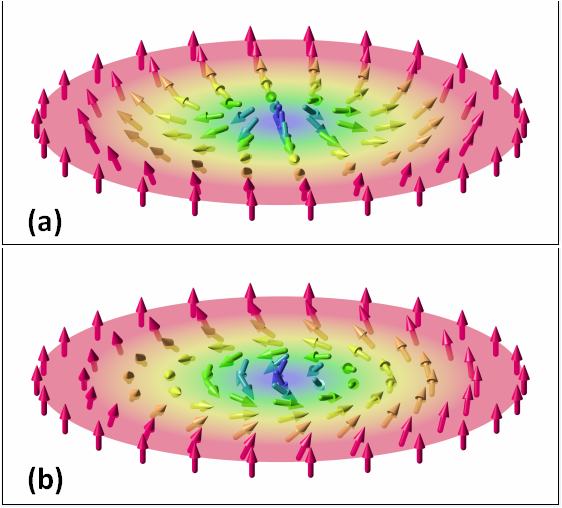Magnetic skyrmions: New bits of spin
By Jennifer Garland, Applied Physics & Mathematics, 2021

Electrons have a fundamental property called spin, which can have an orientation value of ½ or -½ — up or down. Figuring out how to induce particular directions allows the spin to represent and carry information, similar to the more familiar zeros and ones of electrical charge in computer logic. The 2007 Nobel Prize in Physics for giant magnetoresistance recognized the significance of harnessing electron spin to read information from a hard disk drive — it’s faster than traditional methods and allows information storage even after a power source is removed. This field of using the electron’s spin in addition to its charge to store information is called spintronics.
Research into spintronics has risen alongside the development of nanodevices and the strive for lower power use and physical storage space. Smaller devices and lower-dimensional materials are leading to further study of materials, their quantum behavior, and methods of controlling their behavior.
Some materials can contain magnetic skyrmions — nanometer-sized swirls of spin. These swirls act like a particle and can be created, destroyed, and manipulated with electrical current or voltage for information storage.
These swirls act like a particle and can be created, destroyed, and manipulated with electrical current or voltage for information storage.
Skyrmions are special because they are topologically protected, which means that their spin configuration is preserved and resistant to structural imperfections. The center of the skyrmion has a magnetization in the opposite direction as its boundary, and flipping the orientations of many spins is difficult. This stability, arising from an effect called the Dzyaloshinskii–Moriya interaction (DMI), is needed to accurately transmit information and makes them a frontrunning candidate for use as bits among similar quasiparticles such as magnetic bubbles.
The Néel- and Bloch-type skyrmions, each with a different spin configuration, are the most common occurring in multilayer and bulk systems. Though many instances of skyrmions have been observed since their experimental discovery in 2009, there is still a search for the most suitable host systems. In order to use skyrmions for information storage, they need to be written, transmitted, and read. Each of these steps has its challenges: formation must use low energy and create very small skyrmions, transmission through the material must occur rapidly, and reading requires the skyrmions to be electrically detected.
Reading and writing skyrmions can be performed with scanning tunneling microscopy (STM). By using current pulses, defect sites can be created in materials where the skyrmions can nucleate in less than a nanosecond. Quick formation time means that information can be processed more quickly. Though the word “defect” has a negative connotation, defects are often vital to producing desired qualities in materials. Because no perfect crystals exist, the role of further defects and lattice inhomogeneities also needs to be investigated.
Even though skyrmions are on the nanometer scale, they need to be especially small, around or under 10 nanometers, to allow for fast information transmission, high density storage, and low energy consumption. More research is needed to understand how to control the size with parameters such as the material, temperature, and magnetic field to consistently reach this goal.
Additionally, for use in devices, skyrmions must be stable at room temperature and under zero or low magnetic fields. For a while, they were only observed at low temperatures and high magnetic fields, but the first instances of skyrmions at room temperature were discovered in magnetic multilayers in 2015 and 2016.
The materials development for spintronics is critical, as simpler metals that can be manipulated with less power could replace semiconductors like silicon in current electronics.
Skyrmions have typically been found in thin films and multilayers of magnetic materials, but thin films are not conducive to actual device integration, partly because of their slow growth techniques. Previous studies have favored ferromagnetic materials, but recent research has shown that ferromagnets have limits for both the size of skyrmions and their transmission speed. Moving forward, ferrimagnetic and antiferromagnetic materials have proven more promising.
The materials development for spintronics is critical, as simpler metals that can be manipulated with less power could replace semiconductors like silicon in current electronics. Memory and logic devices that integrate magnetic storage are important for reducing energy and material consumption in our increasingly information-dense world, and these bits of spin just might be the key.
DOI: 10.1038/natrevmats.2017.31
DOI: 10.1093/nsr/nwy109
DOI: 10.1063/1.5048972
